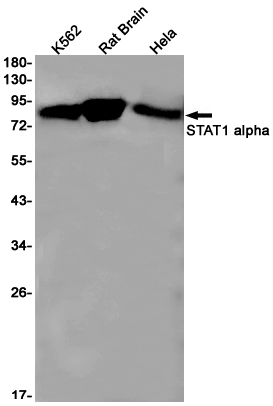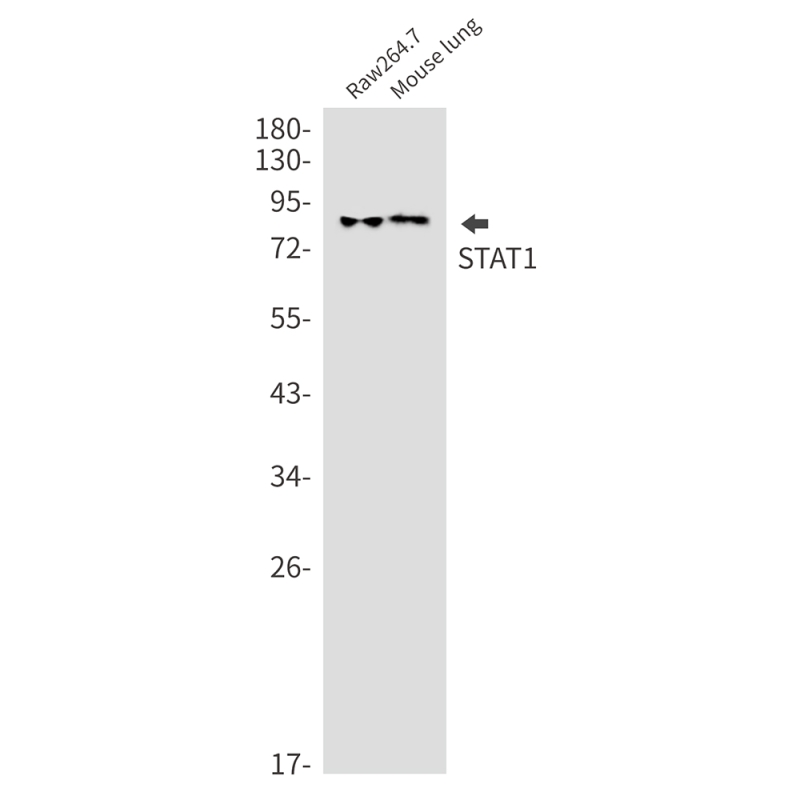

| WB | 1/500-1/1000 | Human,Mouse,Rat |
| IF | 1/20 | Human,Mouse,Rat |
| IHC | 咨询技术 | Human,Mouse,Rat |
| ICC | 技术咨询 | Human,Mouse,Rat |
| FCM | 咨询技术 | Human,Mouse,Rat |
| Elisa | 咨询技术 | Human,Mouse,Rat |
| Aliases | STAT1; Signal transducer and activator of transcription 1-alpha/beta; Transcription factor ISGF-3 components p91/p84 |
| Entrez GeneID | 6772 |
| WB Predicted band size | Calculated MW: 87 kDa; Observed MW: 87 kDa |
| Host/Isotype | Rabbit IgG |
| Antibody Type | Primary antibody |
| Storage | Store at 4°C short term. Aliquot and store at -20°C long term. Avoid freeze/thaw cycles. |
| Species Reactivity | Human,Mouse,Rat |
| Immunogen | A synthetic peptide of human STAT1 alpha |
| Formulation | Purified antibody in TBS with 0.05% sodium azide,0.05%BSA and 50% glycerol. |
+ +
以下是3篇涉及STAT1抗体的代表性文献,按发表时间排序:
1. **"STAT1 regulates senescence and proliferation in endothelial cells"**
- **作者**: Y. S. Kim et al.
- **摘要**: 研究STAT1在血管内皮细胞衰老和增殖中的作用,利用STAT1抗体通过Western blot和免疫荧光验证STAT1的激活状态,发现STAT1的持续激活促进细胞衰老并抑制增殖。
2. **"A novel STAT1 mutation causing chronic mucocutaneous candidiasis with autosomal dominant inheritance"**
- **作者**: M. M. Müller et al. (2012)
- **摘要**: 报道STAT1基因突变导致慢性黏膜皮肤念珠菌病的机制,通过STAT1抗体进行免疫沉淀和磷酸化分析,揭示突变导致STAT1功能获得性异常激活。
3. **"Enhancement of interferon signaling by STAT1 antibodies directly conjugated to inhibitory oligonucleotides"**
- **作者**: C. A. Leaman et al. (2005)
- **摘要**: 开发了一种结合STAT1抗体和抑制性寡核苷酸的复合物,用于增强干扰素信号通路,实验通过流式细胞术和免疫印迹验证STAT1的靶向效率。
4. **"STAT1 activation by interferon-γ induces proinflammatory responses through spatial control of gene expression"**
- **作者**: D. E. Levy et al. (2001)
- **摘要**: 经典研究阐明了IFN-γ通过激活STAT1调控炎症基因的机制,使用STAT1抗体进行染色质免疫共沉淀(ChIP),揭示STAT1在启动子区域的动态结合模式。
以上文献涵盖STAT1在信号通路、疾病机制及实验技术中的应用,均涉及STAT1抗体的关键实验验证。
STAT1 (Signal Transducer and Activator of Transcription 1) is a transcription factor critical for mediating cellular responses to cytokines, interferons (IFNs), and growth factors. It plays a central role in the JAK-STAT signaling pathway, where it is activated by phosphorylation upon receptor-ligand binding. Once phosphorylated, STAT1 forms homodimers or heterodimers with STAT2 or STAT3. translocates to the nucleus, and regulates the expression of target genes involved in immune responses, cell growth, apoptosis, and antiviral defense.
STAT1 antibodies are essential tools for studying its expression, activation, and functional mechanisms. They are widely used in techniques like Western blotting, immunohistochemistry (IHC), immunofluorescence (IF), and flow cytometry to detect STAT1 protein levels, phosphorylation status (e.g., Tyr701 or Ser727 residues), and subcellular localization. Phospho-specific STAT1 antibodies help distinguish activated STAT1 from its inactive form, providing insights into signaling dynamics. Dysregulation of STAT1 is linked to immune disorders, cancer, and infectious diseases, making these antibodies valuable for research on autoimmune conditions (e.g., lupus), viral pathogenesis, and oncogenic signaling. Commercially available STAT1 antibodies are often validated for specificity across human, mouse, and rat models, with common clones including 9H2. D1K9Y, and STA-1. Researchers rely on these reagents to explore STAT1's dual role as a tumor suppressor or promoter, depending on cellular context, and its potential as a therapeutic target.
×